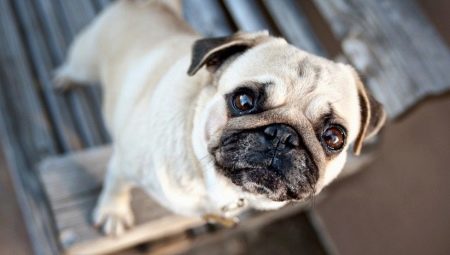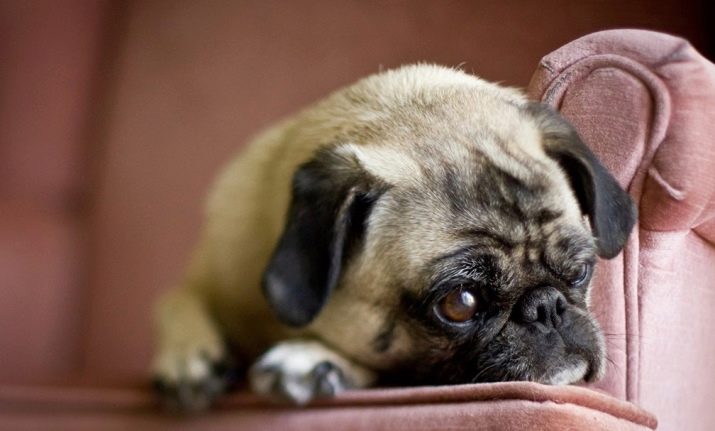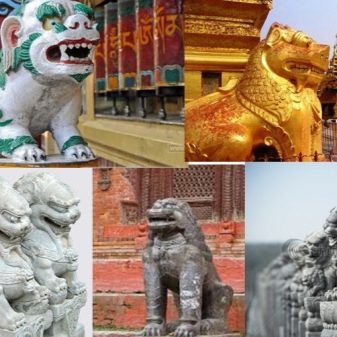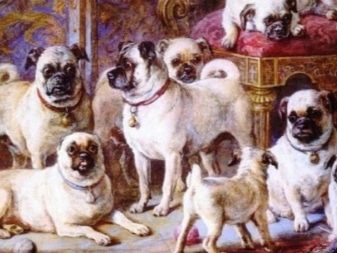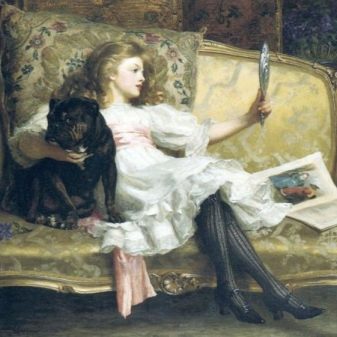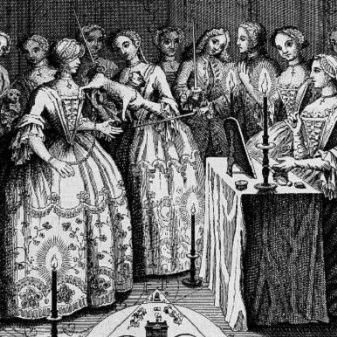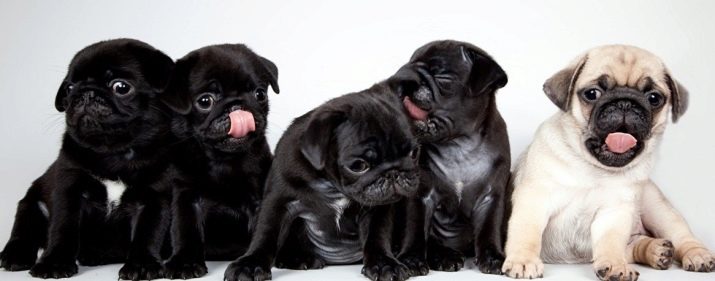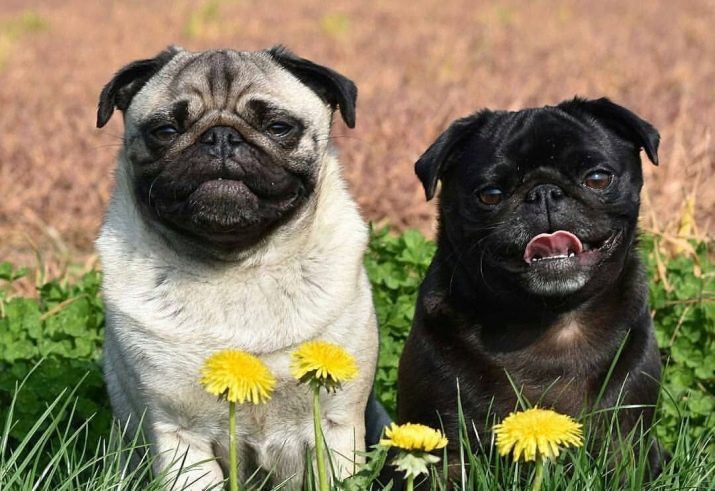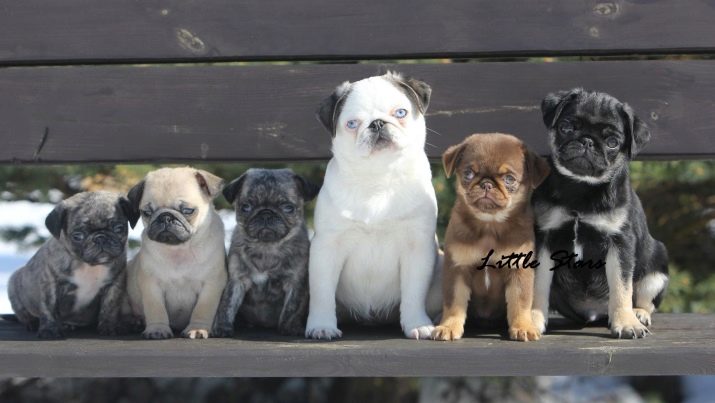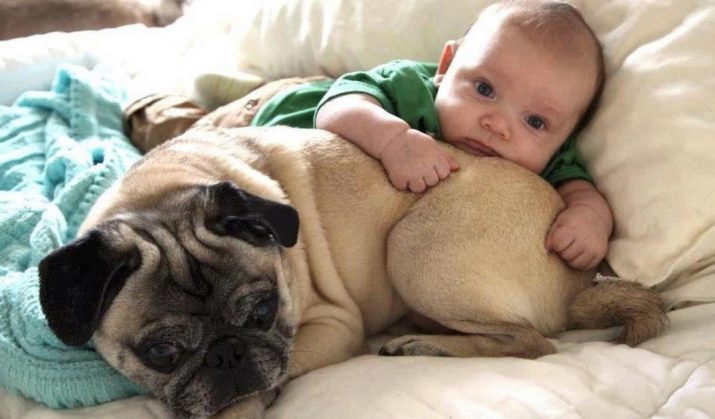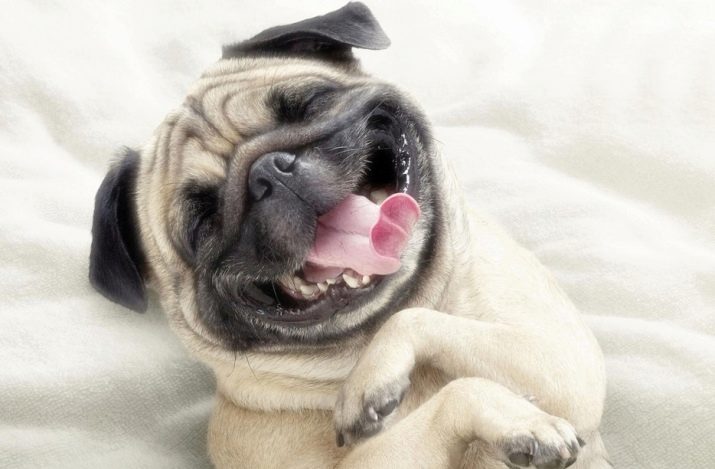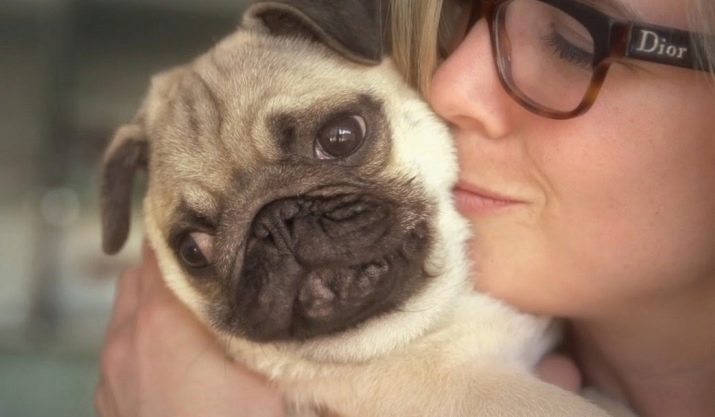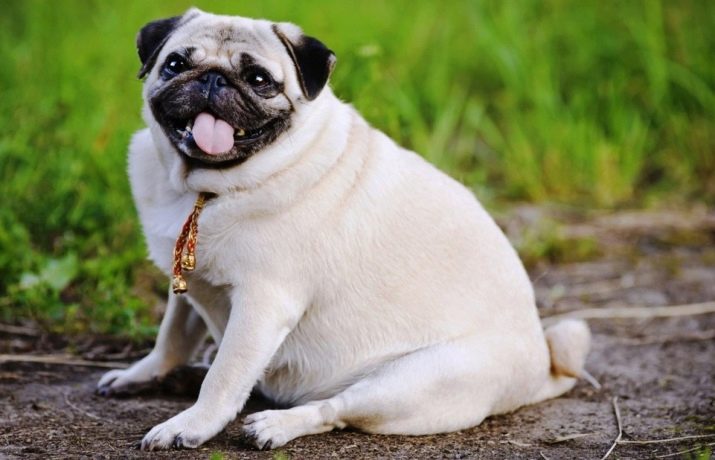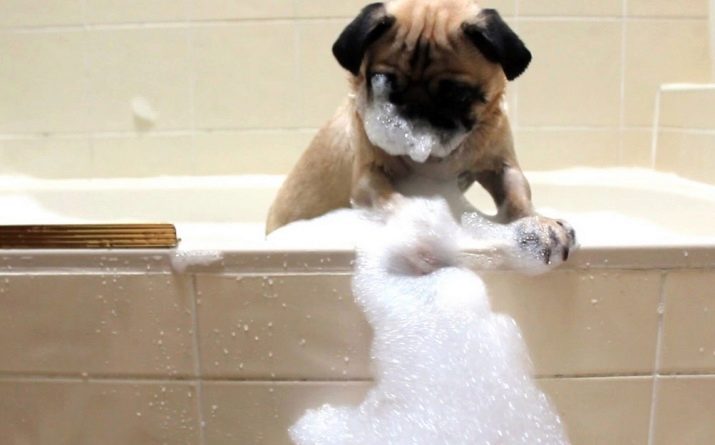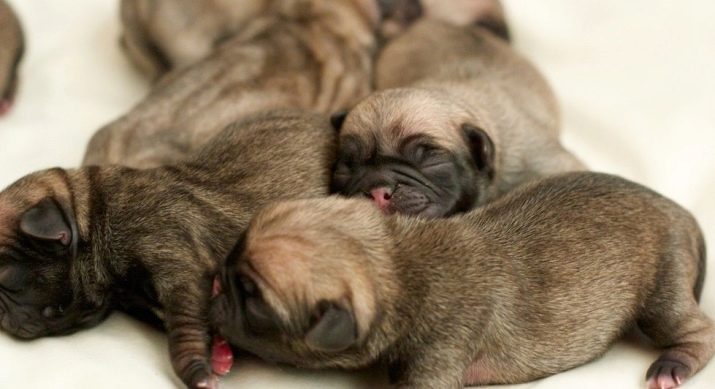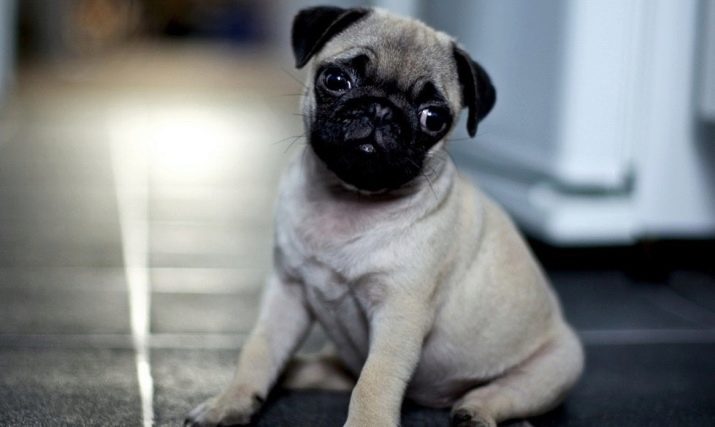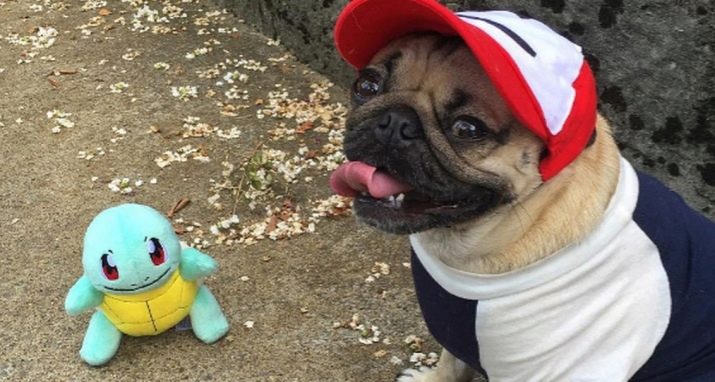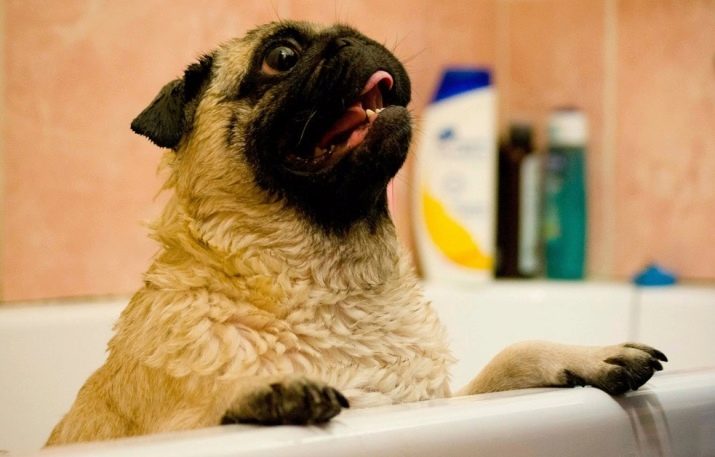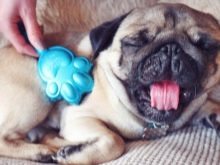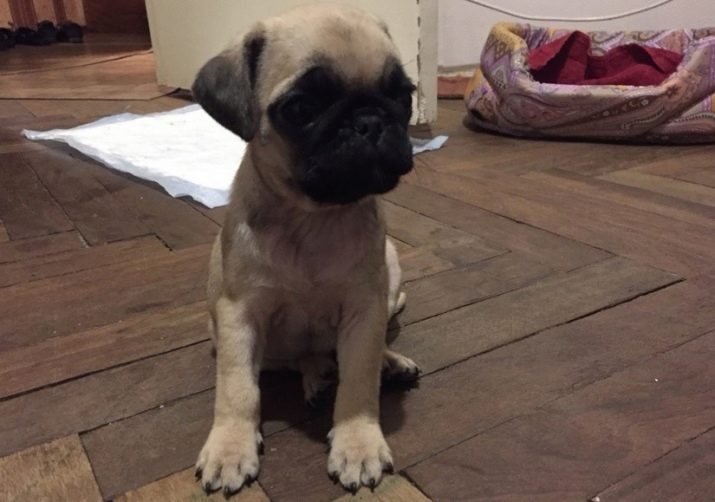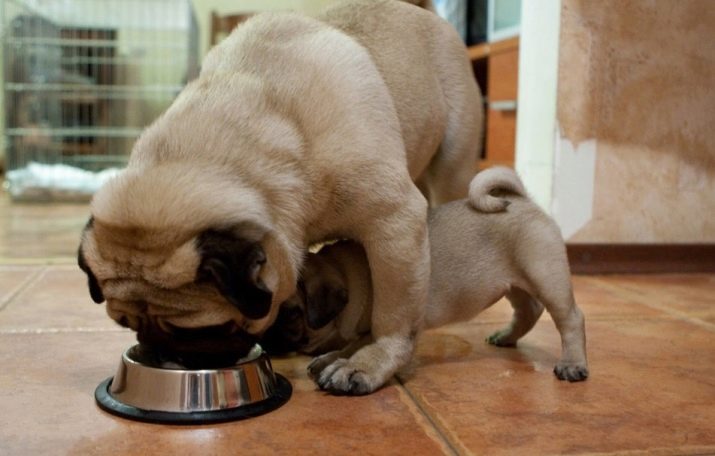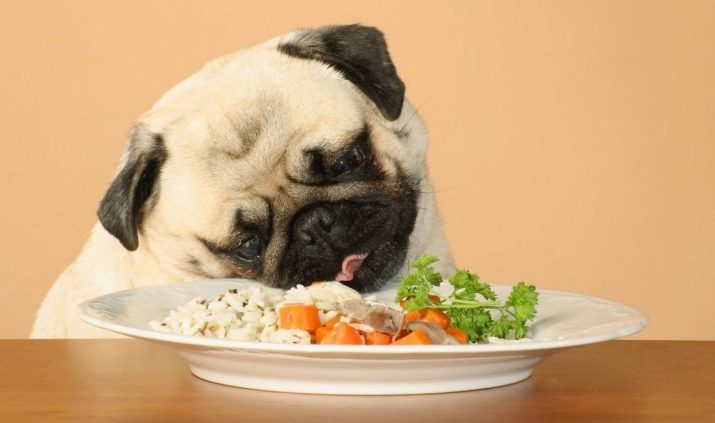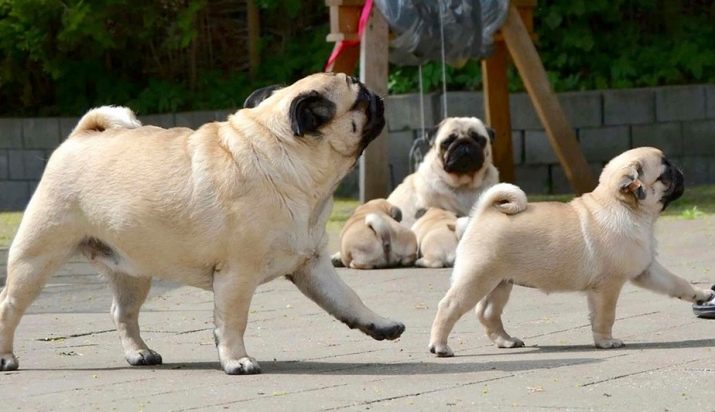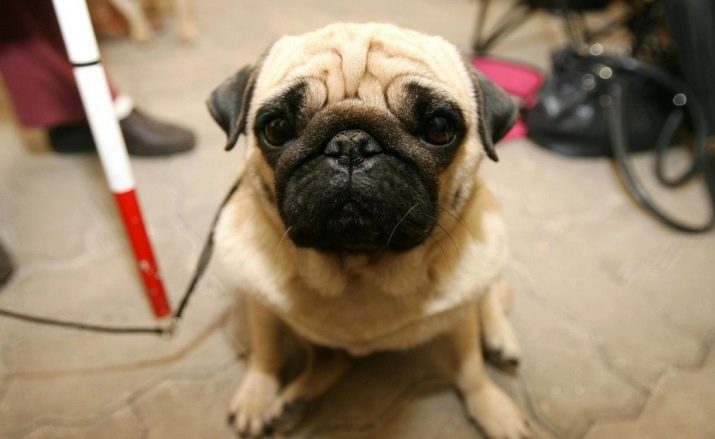Pugs are one of the most charming dogs, good-natured pets that are very hard to refuse. These are great companions who easily find common language with other animals. The breed has millions of fans all over the world, and it is always included in the ratings of the most sociable pets.
At first glance, dogs with a clever clear look and a sad expression of the muzzle make them want to warm and feed them.
But in addition to the expressive appearance and excellent acting data, this breed has a lot of other significant advantages.
One of them - the complete absence of aggression, which makes Pugs the ideal companions for children, the elderly, and people with special needs. With such a dog, you can easily afford an active lifestyle or become a full-fledged homebody. Pug willingly support any mode of the day, does not require long walks or difficult care.
History of origin
Externally similar to typical European molossians, pugs have a slightly different origin. Their homeland is Ancient China, where compact dogs with silky hair were integral companions of the nobility. Unlike many other breeds, the story of their origin is not based on myths and legends, but on real facts.
Historical documents dating back to the 6th-4th centuries BC are considered to be one of the first mentions of dogs with a characteristic phenotype and a shortened face. The texts of the ancient Chinese philosopher Confucius also contain references to the ancestors of modern pugs — lo jie, whom the local nobility preferred to carry on its chariots.
European fame
Outside China, representatives of this breed have come many centuries later. It is believed that one of the first Europeans to get an exotic pet at their disposal was the legendary traveler Marco Polo. But the dogs gained real popularity with the onset of the XVI-XVII centuries, when their original appearance and kindness were appreciated by European monarchs.
The successful coincidence of the color of dogs with the flowers of the ruling dynasty of the Kingdom of the Netherlands led to the fact that it was in Holland that lo jie found a second home. They also got their new name “pug” here. And after the faithful dog Pompey literally saved the life of its royal owner, Wilhelm the Silent, the fame of fearless domestic dogs with a charming external appearance spread throughout the Old World.
And even after the death of the owner, the image of this pet remained in the centuries as a sleeping dog carved on the lid of the sarcophagus, and the founded dynasty found its living mascot.
English period
In the UK, where the animals have always had a special relationship, pugs got about two centuries ago. At the request of Queen Victoria, one of the best representatives of this breed was brought into the country. And soon the love of the monarch's persona led to the formation of a whole population of English pugs - light-colored dogs with an elongated type of muzzle, high legs and a burnt body.
Later, as a result of military operations, black lobsters from China, who remained unknown for a long time, came to the Western countries from China. Unusual dogs have grown instantly in value, and are still considered very rare and expensive.
The first club of breed lovers also appeared in the UK at the end of the XIX century.
After this breeding became more centralized, specialized literature appeared. The first standard was developed in 1888.
Breed Description and Standards
A typical dog description of a breed implies that the animal meets the specified standards adopted by FCI in 1966. Both the puppy and the adult pug look very unusual, have pronounced folds. The characteristics allowed by the modern standard: growth range 25-30.5 cm for females, up to 33 cm for males. Permissible body weight 6-8 kg.
Initially, in the XIX century, a weight of 7 kg was considered the norm, a height of 30.5 cm.
Too large pug also does not fit into the standard, as well as too small. The dwarf moloss must have all the characteristics of its class: a proportional body, a large head, and strong limbs. Mini-format does not imply increased folding, the dog should look natural for its size, without a hypertrophied amount of skin.
Requirements for the balance of articles dogs have led to the fact that pugs with old breed physique, almost no chance for a successful show career. In total, there are 4 main phenotypes.
- Terrier. Considered the most preferred. It is characterized by a slightly elongated torso, expressive proudly planted neck. In dogs with such a physique today is well formed performance at a dog show of any level.
- Sharpein. It is considered the least characteristic of the breed, causes serious complaints from the judges. Dogs of this type have an overweight, plenty of folds throughout the body. As a rule, such an addition is formed intentionally in order to hide the disadvantages of the topline - sloping, excessive elongation of the back.
- Bulldog. This type implies the presence of an oblique set of blades, an overly wide, barrel-shaped torso. The forelegs may have turned elbows. The dog looks squat, short-legged, disproportionately wide in the chest.
- Dwarf. Mini-variety bred in the United States. It includes all dogs weighing less than 4 kg, and not more than 21 cm tall.
The tasks of breeders in the first place include the preservation of the main breed type of pug, compact and strong, with an expressive appearance, balanced parameters of height and weight.
Proportions
According to FCI requirements, a pug must have proportions corresponding to the breed standard.
- Body type. This is a dog with a square body format, pointedly stocky, compact, without excessive moisture, with developed muscles. The body is short, tightly knit. The topline is straight and level, without a hump, sagging. The rib cage is wide, the ribs well outlined.
- Limbs medium length, emphasizing the correct physique. Height from withers to the tip of the paws corresponds to the length of the body from the chest to the base of the tail. The shoulders of the front have a good angle of inclination, the legs are straight, strong, are under the body, the fingers are collected, black claws are obligatory. Rear - set straight and parallel, with a pronounced angle of the knee. Manifestations of short-haired, excessively long or thin legs are excluded.
- Tail high landing, twists in the area above the thigh. Breed is considered a double curl tail.
- Neck strong, thickened, length provides a proud headset. There is a slight bend, like a ridge. The disadvantage is the thin or excessively short neck of the dog.
- Head round shape, bulk. Quite large, but proportional to the body. The disadvantage is apple form. The skull without depressions, the folds in the forehead area are clear, without any extra depth.
- Nose without folds above it. Only black is allowed, the nostrils should be large, well-defined, of sufficient width. Unpainted nose is a serious defect.
- Muzzle with pronounced nasal fold.Short, square-shaped, obtuse, with no signs of sticking up. The nasal crease should be so deep that it does not overlap the nose or eyes, interfering with the animal.
- Dental system with a light snack. The lower jaw is very wide, the incisors are almost straight. When the mouth is closed, no teeth or tongue should be visible. The defect is the staggered arrangement of the lower incisors.
- Eyes round, rather large, dark brown. The expression should be attentive, gentle. The maximum brilliance, fire that fills the eyes when the dog is excited emotionally is obligatory. The disadvantage is excessive bulge, the appearance of the edge of the protein when the dog is looking forward. Defects also include low or wide eyes.
- Ears There are two types. The most pedigree is considered a "button", laid forward, with a tight fit of the edge to the head. The shape of the ears "rose" suggests a small size of the shell, raised cartilage, retracted tip. The correct version resembles black velvet. To the touch ears are thin and soft.
Color options
All allowable types of color are clearly described in the breed standard. The shiny thin pug hair is always smooth and short, rather thin. The breed may be beige, apricot or peach (with red in tone), silver, recognized in the EU and the USA, or a black basic background. Markings should be as close to black as possible. Pugs should have a “belt” on their backs, a muzzle or a mask contrasting with the basic tone (except black), ears, a “diamond” in the forehead and “birthmarks” on the cheeks.
Light colors must be present pronounced difference between the background and dark patches. The stronger the contrast, the higher the score. A white spot on the chest is considered a disadvantage. In the black color should not be interspersed with red hairs. Beige can be whitewashed, almost to ivory.
Non-standard color options can be very different.
- Pug albino It is characterized by a snow white color with a contrasting black face, or completely devoid of dark patches.
- Steel or light gray.
- Chocolate with light brown nose.
- Brindle, with pronounced stripes. It turns out when mixing the blood of dogs of different colors.
- Pale yellow with a chocolate-brown mask.
- Marble with a silver-beige background and black spots.
Dogs of these colors are not found in the show ring, but become excellent pets.
It is important to consider that puppies of a pug with a change of color. To avoid surprises, you should pay attention to the puppy's ancestors - to study the dominant shades of coat.
Character
The sweet nature of these small dogs often becomes an occasion to get them into a family with children or pets. But there are subtleties that are known only to experienced breeders. The general ease of character that pugs possess is indeed present. But in fact, the playful and active dog remains only in his youth. As they grow up he will turn into a reference homebody, a denizen of the sofa.
Character traits make representatives of this breed comfortable in content for those people who often have to travel on business trips. At the time of taking care of a pug, you can entrust friends or relatives, the dog easily adapts to temporary conditions of stay. A big advantage is the lack of habit to cast a voice over trifles. The only sounds that most hosts hear are left characteristic snoring and manifestations of flatulence in animals.
Matters and gender dogs. The girl is always more contact, controlled, better manageable. It is worth getting people unwilling to the rapid manifestation of feelings.
Surprisingly, in this breed, women represent a balanced temperament.
Boys are much more stubborn and have their own "look" at training. Such a pet is quite difficult to train in adulthood. As well as individuals of the male have a more violent temperament, can demonstrate an incredible activity when the host returns home.
In general, a dog can be recommended for purchase to those who want to find a true friend and an active, emotional companion for many years. Due to increased independence, it will be difficult for a child or an elderly person to cope with it.
Advantages and disadvantages
Evaluating the pros and cons of the breed, it is safe to say: a pug is almost an ideal pet, and small minuses only give it additional charm.
Among the obvious advantages of these dogs are a number of factors.
- Attachment to man. Pugs are born companions who need to express their attachments. They willingly demonstrate feelings to their beloved master, they easily make contact, generously bestow their love on all family members. If you need to choose between communicating with your beloved owner or confreres, the pug will choose the opportunity to be with the person.
- Friendly to children. Pugs can safely be left alone with an infant or preschooler, without fear that the dog will offend the baby. Children themselves are very gentle with pets with silky velvet fur. You can safely allow them to play together or have fun. But before you start a pet, it is worth teaching the child the proper treatment with him.
- Pretty good health. Pug dogs are not carriers of most of the genetic diseases characteristic of small molossus. They are fairly well protected due to their strong immunity. But when choosing, it is worthwhile to carefully monitor the pedigree of the dog, to buy it in proven kennels, to follow the recommended diet for life.
- Charming appearances The unique look of these small dogs attracts the eye like a magnet. They do not leave indifferent even the most severe heart.
- Compact size. A miniature pet easily fits even in a small-sized housing, does not bother its owner when living together.
- Brave Heart. Despite the very modest size, the pug is courageous and ready to rush to protect the owner or warn him about the danger. Even to the guests, despite the general good nature, the dog always always shows a certain distrust.
- Easy to adapt. Pug - the dog with which you can afford any mode of the day. Pet easily adapts to the requirements of the owner and will be a convenient companion in everyday affairs.
- Versatility - suitable for owners with any experience. Minimal needs for physical activity allow even older people to enjoy walking with a pug. The dog will not attempt to escape, will slowly follow next.
- Minimal care time. You do not need to regularly cut hair, comb the undercoat, spend a lot of time preparing for the exhibition.
The disadvantages are also present. Dogs breed pug differ overly gullible they easily go to strangers, can take a treat from their hands or let themselves be led away. Another problem - omnivorous and gluttony. The tendency to corpulence in miniature dogs is quite common, but these dogs are superior to all others in terms of weight gain.
Eternal nutritional restrictions lead to the fact that the dog is ready to eat any conditionally suitable foods.
Stubbornness is not at all what the owner expects from an always agreeable pug. But one has only to begin training, and this trait of character will manifest itself in all its glory. In addition, animals need constant attention, they are self-centered, love to be the "center of the universe" for the owner, his family members.
Dogs poorly tolerated loneliness, very bored, can begin to bully In addition, they are touchy, able to deprive their master of attention, ignore his commands after being mistreated.
Among the physical features of the breed is worth noting the abundant year-round molting. The host will find hairs both on the front dress and on home slippers. Another important point - high need for hygiene, the rapid appearance of unpleasant smell.
Lifespan
Pugs, like other miniature dogs, may well live a long and happy dogish age. The average age of animals reaches 13-14 years, but individual specimens significantly exceed these limits.
In order not to face the early death or health problems of the pet, breeders recommend checking the results of the genetic tests of the parents.
Among the hereditary problems that are dangerous to the life and health of the dog, it is possible to identify dysplasia of the hip joints, encephalitis, epilepsy, spinal deformity. Most often, these problems are associated with closely related crossbreeding of dogs, use of animals with obvious genetic defects in breeding.
How to choose a puppy?
Many people dream of becoming the owner of a little pug. What you need to know before acquiring an animal, what newborn puppies look like, who is better to choose from a litter, and at what age it is better to find the answers to all these questions before you have to make a final decision.
Among the selection criteria can be identified a number of points.
- Pet class. If you plan to conduct exhibition activities, you should choose puppies of the show class from titled producers with impeccable exterior. Offspring of the category of breed is slightly cheaper - it is allowed for breeding, but may have slight defects in appearance. Pet-class allows non-standard colors, you should not hope for an exhibition career or sale of puppies.
- Gender. Boys are brave, sociable, intelligent dogs with a developed sense of territory. They can mark their own living space, but otherwise do not cause trouble. Girls - more calm, confident. The innate behavior of the lady changes only twice a year during estrus, but with a sterilized dog, this problem is completely eliminated.
- The age of the animal. You can take a pug puppy home no sooner than he turns 1.5 months. But a more reliable option would be to purchase an already vaccinated pet. The optimal age is 2.5 months and older. You need to feed a puppy and feed less frequently - about 4 times a day, without nightly ascents.
- Social adaptation. A puppy by the time of separation with the mother should play with peers, it is easy to come into contact with people, not to show aggression or fear. If the breeder keeps the litter in a cramped cage or corral, does not allow him to walk, the new owner will have to fix his pet's behavioral problems all his life.
- Health. The animal should not have skin rashes, dandruff, discharge from the eyes, ears, genitals. The body and paws of a healthy baby are thick, proportionally developed. The smell from the animal should emanate pleasant and dull. The presence of parasites - fleas, ear mites - indicates poor care.
All puppies at the time of transfer to the owner must have a puppy card with blank data of the owner, the stamp, the number is the same as indicated in the documents. The vaccination certificate must contain information about vaccinations.
Maintenance and care
When purchasing a pug, it is important to remember that this dog needs the attention of the owner, and care for a short-haired pet, although it may seem tedious, brings joy to both the owner and the animal itself. The main thing is not to turn hygienic procedures into a heavy duty, and take care that both the puppy and the adult or old dog receive the necessary amount of physical activity.
Walking
The pug is a strong strong dog with good musculature. But due to mobility limitations, he can quickly gain unwanted fat reserves.Help overcome physical inactivity.
True, in the case of pugs here will have to adhere to three important rules.
- Systematic. Daily walks are useful and necessary dog. For a small indoor dog will be enough two half-hour promenades - in the morning and evening hours. In extreme heat, walking is better to postpone for a time when the air temperature is minimal, it is sunrise and sunset. In winter, it will be enough to take out the dog for 15 minutes twice a day - pugs are completely unsuitable for cold weather.
- Game loads. The dog should receive a moderate level of physical activity. It is worth from childhood to teach a dog to play in the open air, easy jogging, not forgetting time to rest. When dyspnea occurs, the pet takes a break.
- Rich wardrobe. Due to the difficulties with thermoregulation, dogs of this breed need to purchase clothes according to the season. Warm overalls, boots, blankets will help to preserve health and will save the pet's organism from hypothermia.
Choosing clothes
Consider what kind of clothes a pug needs while walking. First of all, the wardrobe should be matched in size and season. For winter, it is better to choose bright clothes with reflective stripes. Warm jackets, coats, overalls of different lengths will be appropriate here, in the products with pants the groin area remains open. Well, if the top is provided with a hood to protect the head, in heavy frosts, a fleece or knitted blanket is hooked down.
Demi-season clothing of pugs is considered a raincoat, it can be equipped with a little warming, look like a windbreaker or a light robe.
Heat is not a reason to leave a dog without clothes. To protect against overheating, the dog must wear a panama and light cotton jumpsuit. All materials for clothing pugs must be breathable, contributing to normal thermoregulation. It is very important that the attire does not constrain movement.
In addition to outfits for walking, the owner will need a harness and leash, Collars these animals are not too comfortable to wear. It is better to choose high-quality leather accessories that do not interfere with the dog's standing, walking, running. Clothing must be provided places for fastening the leash on the ring brace.
Bathing
Dogs of the pug breed have a special protective cover on the skin and wool - it looks like a fatty film that naturally protects the body from cold, overheating, moisture and other external influences. When bathing, this layer is washed off and re-formed for quite a long time. That is why often do not bathe the pet.
It will be enough to take a bath with heavy pollution and according to the schedule - once every three months. If possible, wash the dog with or without special soft shampoos using warm water.
When preparing to receive water procedures, it is worthwhile to ensure that the animal does not freeze after them. All sources of draft are necessarily excluded, the temperature in the room rises to a comfortable +25 degrees Celsius. Pugs do not differ cowardice and are great for bathing. At the bottom of the bath is enough to lay a non-slip mat, and you can water the pet directly with a shower head on a flexible hose.
Dog's ears pre-closed with cotton swabs to prevent water from entering the ear canal.
General hygiene procedures
Regular hygiene procedures are very important for successfully maintaining good dog health. In order for a pug to look and feel good, it is necessary to regularly carry out manipulations with it for this breed.
- Cleansing skin folds. Inside the wrinkles may linger the remnants of food, pollution that fall during a walk on the body of the dog. It is the wrong hygiene of the folds that leads to the fact that the animal begins to smell unpleasantly, inflammation occurs on the skin, areas with diaper rash.To prevent such problems, wipe all folded areas with at least two times a week with hypoallergenic wet wipes. After bathing, wrinkled skin is thoroughly dried, leaving no moisture.
- Combing the coat. The pug's short hair sheds quite abundantly, his fur coat needs a weekly thorough brushing with natural hair. This cleaning helps to remove pollution, stimulates blood circulation. With abundant molt, it is worth making the hygienic treatment more frequent.
- Cleaning the ears. Features of the structure of the ear of a pug is such that it does not need too intensive care. It is enough to wipe the inside twice a month. A soft cloth moistened with boric alcohol is used for processing. After the procedure, dried skin is powdered.
- Eye care. Slightly bulging eyeballs increase the risk of injury and need special attention. Examination of the eyelids and the skin around is performed daily, whitish or gray dirt is found to be removed with a damp cotton pad dipped in chamomile broth. With excessive tearing, the formation of purulent discharge, you should definitely visit the veterinarian.
- Grown short claws. The lack of intense physical activity leads to the fact that the natural way grinding does not occur. Horny layer must be removed with the help of special "pedicure" accessories. Nippers guillotine will help to make the process less traumatic, and the file will avoid splitting the tips on the cut. Uncut claws gradually begin to twist, dig into the paw pads, hurt.
- Teeth cleaning. Features of dog bite require the most careful attitude to oral hygiene. Enamel processing with a brush and specialized toothpaste is made 2-3 times a week. You should carefully monitor the condition of the gums, the presence of caries, tartar, when they appear, contact a doctor.
- Washing paw pads. They are inspected and cleaned of dirt, chemicals. When wounds are detected, they are treated with antiseptics, and foreign objects are removed. In winter, it is recommended to protect the paws of the animal with shoes or socks.
Features of toilet training
Intelligent, active and live pugs easily go to contact with the owner from the first days of their stay in the house. This can be used to quickly teach an animal to the toilet.
Puppies have a good memory, you just need to help them navigate in an unusual situation.
- After waiting for the first puddle, you need to moisten a diaper in it, and transfer it to the prepared tray. Pet shows the place where he will send natural needs. The first month you can use just a diaper.
- After sleeping or eating, you must take the puppy to the diaper, wait until he goes to the toilet. If the puppy "did not reach the place", you need to increase your vigilance, often offer him a visit to the prepared tray.
- For any successfully completed action, you must always praise the baby. This will inspire him to new feats. Pugs really appreciate such attention to themselves, and try to repeat the feat for which they received encouragement.
- After the skill is fixed, the diaper is removed from the tray, the puppy continues to visit the toilet in the usual way. It may take several months to achieve the goal - you should not hurry or use force. Sooner or later, the pug will learn the rules of cleanliness in the house, and will follow them.
Feeding
Pug feeding is pretty simple - these dogs are different. Enviable appetite and do not give up their portions. But the natural tendency to corpulence makes abundant meals deadly for representatives of this breed. The diet will have to limit, carefully following the recommendations of the veterinarian. In choosing the type of food, various options are possible - from ready-made industrial feeds to an individually selected menu.
The frequency of feeding depends on the age of the dog. An adult animal is allowed to a bowl no more than twice a day, giving only water without restrictions. Puppies are fed 3 to 7 times a day, as they grow, the number of servings decreases.
Natural diet
The calculation of the daily amount of food for the dog is based on the weight of its body. This indicator is multiplied by a factor of 0.04. That is, with a mass of 6 kg, a dog can be given no more than 240 g of food. The optimal composition of the food will be as follows:
- about 40% of the diet is raw quality meat (beef, veal, chicken), occasionally boiled fish;
- about 20% should be low-fat dairy products;
- 20% fresh or boiled, stewed vegetables - beets, carrots, zucchini, bell peppers, pumpkins;
- 15% of cereals - rice, buckwheat, oats.
Additionally, the dog relies a small amount of vegetable oil, fruit as a treat, half an egg yolk daily. It is permissible to give cheese, rye crackers. Before giving the animal, the meat is pre-frozen for three days, then doused with boiling water, crushed.
Ready meals
Among the wide range of feeds available on the market, pugs need to choose the best and highest quality. The optimal solution would be a product that takes into account the tendency of the dog to gain weight, its age category, physical condition.
It is worth paying attention to the finished feed of several species.
- Royal Canin Pug Adult. Food designed specifically for pugs. The French brand offers a high-protein, low-fat product. The basis of the composition of high-quality chicken meat. The food is suitable for feeding adult dogs.
- Acana Regionals Wild Prairie Dog Grain Free. Canadian food class holistic suitable for feeding adult dogs, puppies, juniors. The unique formula consists of high-quality poultry meat and fish fillets for more than 50%. In addition, the feed contains valuable fiber and a lot of other ingredients, low calories.
- Orijen Adult Dog Fit & Trim Grain Free. Canadian food series holistic for dogs prone to obesity. Protein volumes reach 42%, based on poultry meat and 4 varieties of fish. The composition contains additives to preserve the health of the joints.
Regardless of the type of dog food, you must take care of the animal's free access to water. It is given only in filtered or bottled form. Fluid change and washing bowls are done daily.
Upbringing
Pug rearing is always complicated by only one factor - the pet's phenomenal stubbornness. Affectionate, trying to please the owner of the dog instantly turns into stubborn pest if he does not like the classes offered by the owner. To avoid problems will help the correct tactics of treatment of animals. And the main weapon of the owner here is affection and care.
For praise, the pug will even be ready to overpower himself, and will perform actions that he considers stupid or boring.
The right choice of age to start classes is everything. Pugs are amenable to education only at an early age, the main training is better to hold up to six months. A favorite tactic of an ill-mannered adult dog is ignoring host commands with simulating temporary deafness. So that the dog does not make it a rule to behave like this in any situation, one should begin training as soon as possible and seek obedience without fail.
Patience - this is what exactly will come in handy pug owners. You can only recalculate a pet gradually, persistently explaining to him what exactly the owner is seeking. The dog can be picked up, calm, distract. And then again to return to classes, gently insisting on his.
Treats in the training of pugs - an important component of success.
You can get results with the help of persuasion and tasty promotion much faster. But do not be zealous.High-calorie supplements should be carefully considered in the total amount of daily food and subtracted from it when preparing portions for feeding.
Owner reviews
The most objective opinion about pugs can be called the reviews of the owners, who are literally ready to be carried in the hands of their pets. Even the disadvantages of dogs like snoring or stubbornness in the eyes of a loving person easily turn into virtues. This breed is often referred to as "clown" for a cheerful positive attitude and the ability to perform various tricks. Even just watching the animal, you can involuntarily begin to smile.
Pugs are dogs in need of company. That is why they are often kept in pairs or in several individuals.
Puppies are incredibly playful, love the attention, looking for the host society. Adult animals are more balanced, like to sleep. In good weather, the pet will not mind walking close to the house, but in general, he does not like the street too much. But the process of dressing and wearing overalls, shoes will be held without special whims.
The need for careful hygiene is also important. The dog will have to wash in the morning, carefully comb, collect its wool in the apartment. Owners have noted that Pugs accustomed from childhood to the rules of hygiene easily transfer all manipulations.
It is worth considering: these dogs love to sit on their hands, including walking. With a body weight of 7-8 kg, this can create a serious load on the back.
About the features of the breed, see the next video.
